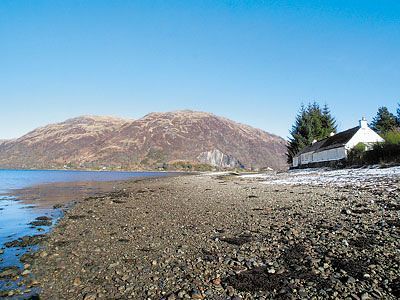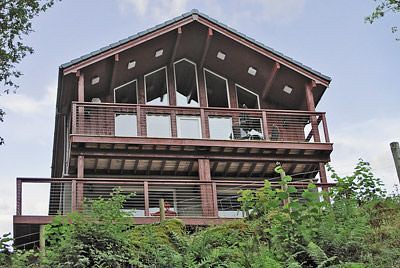Bonawe Historic Iron Furnace
The most complete charcoal-fuelled ironworks in Britain, Bonawe was founded in 1753 and provided thr canonballs for Nelson's battle fleet at Trafalgar.
Displays bring to life the industrial heritage of the area and illustrate how pig iron was made.
Set in stunning surroundings at the head of Loch Etive. Loch Etive sweeps up to Glen Coe where golden eagles are regular visitors. Nearby, the Glen Nant National Nature Reserve, is an example of the woodland that once supplied Bonawe.
Historical Information:
In 1753 a Cumbrian ironmaster opened a new works in Scotland, at Bonawe. The chief attraction was the extensive woodland of Argyll, guaranteeing him an almost endless supply of charcoal. Plenty of water for powering the huge bellows was an added advantage. The iron ore was imported from Cumbria. The location beside the Loch ensured that ships could easily and safely visit the site.
The ironworks proved successful. In its heyday, the furnace produced 700 tons of pig iron annually, and employed up to 600 people, most of them ‘charcoalers’ working in the woods. The works outlasted all the other Scottish ironworks using charcoal as fuel, and when it finally closed in 1876, after 123 years of operation, only Backbarrow, in south Cumbria, remained operational.
Bonawe is the most complete charcoal-fired ironworks in Britain. The entire manufacturing process can be traced:
- The lade – bringing water from the River Awe onto the waterwheel to power the bellows;
- The two vast charcoal sheds – where enormous quantities of fuel were stored in dry conditions;
- The small charcoal shed - where imported high-quality haematite ore was stored, along with the limestone (for removing impurities during smelting);
- The charging house – where the raw materials were weighed and carefully loaded into the furnace mouth;
- The furnace, blowing-house and casting-house – where the iron ore was smelted by cold blast into pig iron;
- The two blocks of housing – where the workers and their families lived;
- Kelly’s Pier – where most of the raw materials were landed, and where all the finished products (mostly pig iron) were loaded onto vessels
Most of the workforce – numbering over 600 – worked in the woods as ‘coalers’, producing charcoal. They were mostly local, and Gaelic-speaking, and were employed in the summer months only.
Around 20 men worked at the furnace. They were experienced men from English-speaking Cumbria. They worked hardest throughout the winter when the furnace seldom ceased operating, and spent their summer repairing and renewing the fabric. They probably worked hardest in the winter when the river flowed fullest.
The furnace mostly produced pig iron for export. However, during the Napoleonic Wars it churned out cannonballs. The workforce was the first in Britain to erect a monument to Admiral Nelson’s memory after Trafalgar in 1805. The standing stone still stands in Muckairn churchyard, in Taynuilt, but the Cumbrian slate plaque is on display at Bonawe.
Travel Directions to Bonawe Historic Iron Furnace
Public Transport
From Glasgow Queen Street station, take First Scotrail train (Oban) to Taynuilt (2hrs 36mins). Walk 11 mins to Bonawe Iron Furnace.
Otherwise sign posted from Taynuilt



